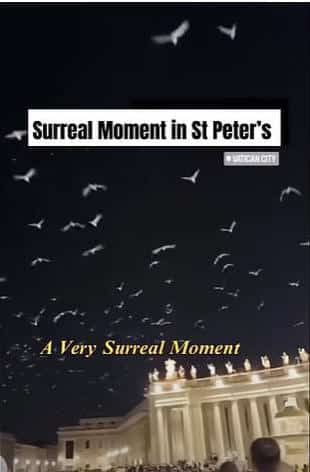There were too many signs around and during the funeral of Pope Francis not to notice.
The internet was abuzz with video clips (TikTok, YouTube, Instagram) of “doves”–a real lot of them—flocking over St. Peter’s Square following the announcement of Pope Francis’s burial date.
But were they actually doves?
It seems at least the majority were seagulls, known to roost near the proximate Tiber River.
But a sight to behold?

Fairly interesting.
Eleven years ago, when the Pope and several children released peace doves in St. Peter’s Square, the pure white birds were attacked by a crow and–yes–a seagull.
Doves have their role. In 236, the Christian community of Rome was debating potential papal candidates when a white dove landed on the head of a bystander, Fabian. “At this, everyone, as if moved by a single divine inspiration, eagerly and wholeheartedly called out that Fabian was worthy,” according to Eusebius, a Church historian of the era.
Here’s one waiting on the smokestack:
Incredible was the moment, after the funeral Mass, when U.S. President Donald Trump and Ukrainian President Vladimir Zelensky sat on two chairs in St. Peter’s Basilica to discuss the war with Russia–a war that Pope Francis constantly mentioned and prayed about.
This is called irony.
Just as fortuitously, the vice president of the United States, and a relatively new Catholic, J. D. Vance, was one of the very last to see the Pontiff alive (on Easter Sunday).
Meanwhile, one is excused for likewise being taken aback by the massive blackout that hit Spain, Portugal, and parts of France not long after the funeral.
It was caused by an “anomalous atmospheric event” (sudden plunges of cold and warm air), disrupting the oscillation of electrical lines, forcing power lines out of sync, and bringing to mind the “great sign” of Fatima: blackouts in Europe in 1938 due to similar disruptions caused by an extraordinary display (in January) of the aurora borealis.
The northern lights were seen by Fátima seer Lúcia dos Santos as auguring a major war foretold to her in secrets intimated by the Blessed Mother. World War Two began shortly after.
Now we have the death of Pope Francis shortly after (on Palm Sunday) he visited the tomb of Pope Pius X, whose own death had occurred in 1914 three weeks after the start of World War One and was said to have been caused by the shock of that great conflict.
An American newspaper, the Salida Mail, pointed out that “grief over start of war [is] thought to have hastened his death.”
Pius X was also famous for his commitment to catechesis and Eucharistic devotion.
It also was reported but not officially stated that Pope Francis had said he wanted to die during the Easter season.
He passed on Easter Monday during morning prayer. Cardinal Timothy Dolan remarked that the timing “couldn’t have been choreographed better.”
Likewise did it come to light that Pope Francis told the rector of Saint Mary Major Basilica the Virgin wanted him to “prepare his tomb”–and the Pontiff did so, in this the greatest church in Rome dedicated to Mary and one based on a miracle.
The wonder had occurred on August 5, 352.
In short, then Pontiff Liberius had a dream in which the Virgin told him to build the church at a location that would be indicated by a miraculous snowfall (remember, this was the height of summer).
This occurred immediately after, an uncanny fall of snow on Mount Esquiline in Rome, where the Pope then had Santa Maria Maggiore built.
Notes viewer Cathy Fernandes, “Will another diplomat like Pius XII be elected to guide the Church through WWIII? World War II began six months after Pius XII began his pontificate. Is it significant that Francis prayed at the tomb of Pius X shortly before his death? According to a Vatican historian, Pius X died of sorrow three weeks after WWI began! Are cardinals looking for a candidate who will continue the legacy of Francis and is also an experienced diplomat? Does Pietro Parolin fit the bill? And, his first name is Peter!”
Perhaps it will be more of a surprise than that.
Stay tuned…
[resources: The Last Secret]






